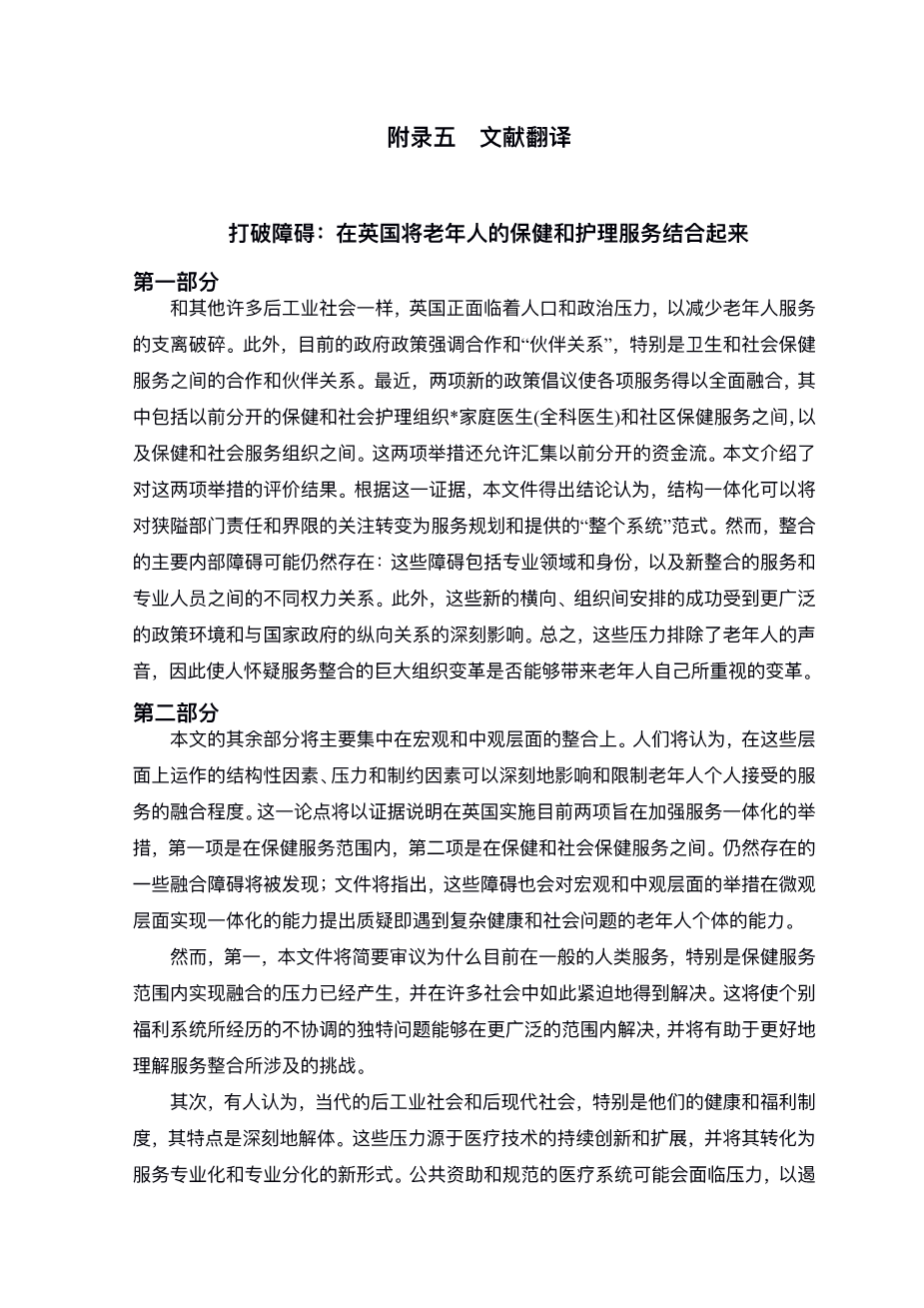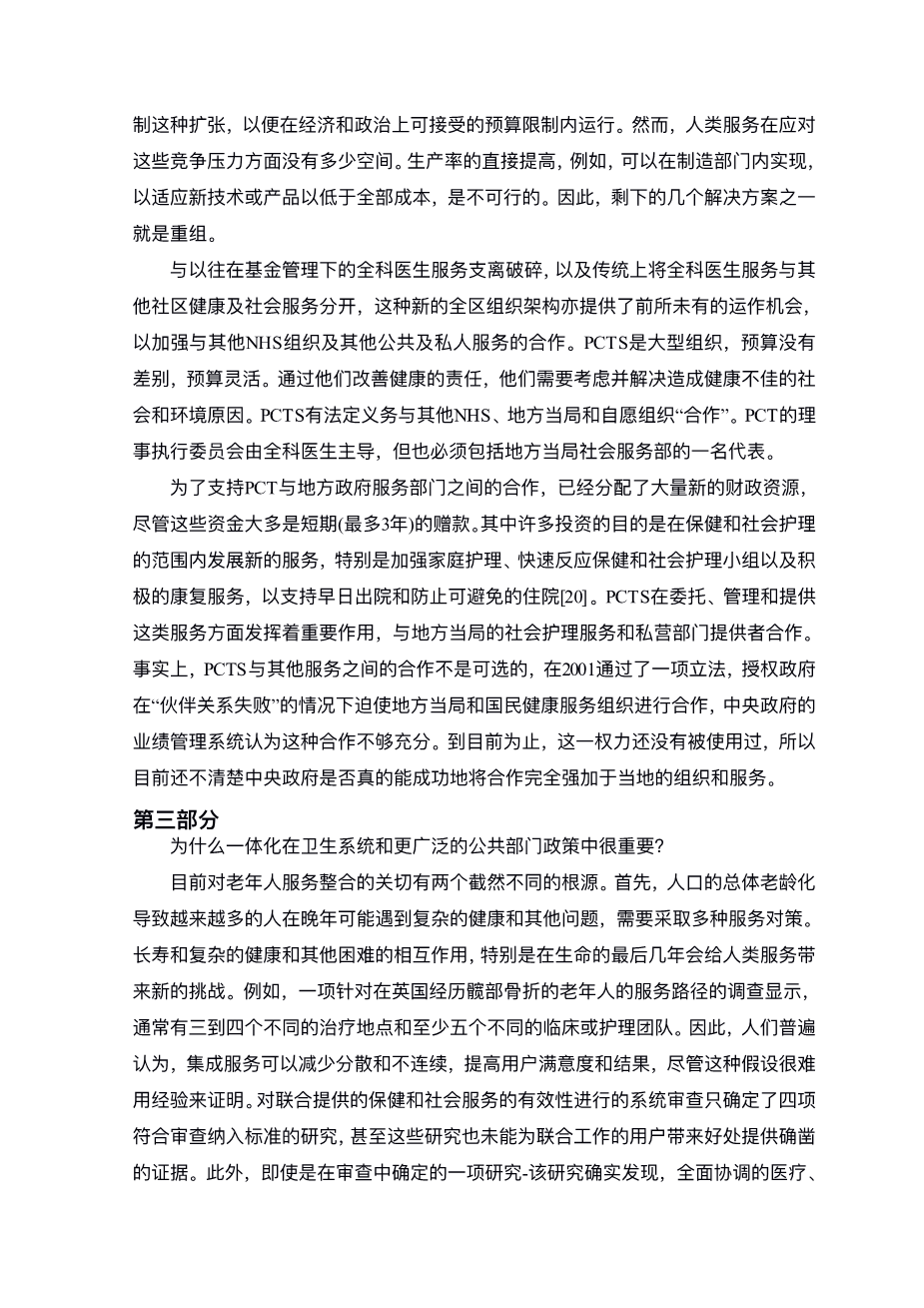附录四 外文文献
Breaking down barriers: integrating health and care services for older people in England
PART 1
Like many other post-industrial societies, England is facing demographic and political pressures to reduce the fragmentation of services for older people. Moreover, current government policies emphasise collaboration and ‘partnership’, particularly between health and social care services. Recently, two new policy initiatives have enabled the full integration of services to take place, involving formerly separate health and social care organizations between family doctors (general practitioners) and community health services, and between health and social services organizations. Both initiatives also allow the pooling of previously separate funding streams. This paper presents findings from evaluations of these two initiatives. Drawing on this evidence, the paper concludes that structural integration can transform preoccupations over narrow sectoral responsibilities and boundaries to a ‘whole systems’ paradigm of service planning and delivery. However, major internal barriers to integration may remain: these include professional domains and identities, and differential power relationships between newly integrated services and professionals. Moreover, the success of these new horizontal, inter-organizational arrangements is profoundly influenced by the wider policy environment and by vertical relationships with national government. Together, these pressures exclude the voices of older people, and therefore call into question whether the considerable organizational upheaval of service integration will be able to deliver the changes valued by older people themselves.
PART 2
The remainder of this paper will concentrate largely on integration at the macro- and meso-levels. It will be argued that structural factors, pressures and constraints operating at these levels can profoundly influence and circumscribe the degree of integration in the services received by individual older people. The argument will be illustrated with evidence on the implementation of two current initiatives in England which are intended to enhance service integration, first within health services and secondly between health and social care services. Some of the barriers to integration which remain will be identified; the paper will argue that these barriers also raise questions about the capacity of macro- and meso-level initiatives to deliver integration at the micro-level*the level of the individual older person experiencing complex health and social problems.
First, however, the paper will consider briefly why the current pressures for integration, within human services in general and health services in particular, have arisen and are being addressed with such urgency in many societies. This will enable the unique problems of poor co-ordination experienced by individual welfare systems to be located within a wider context and will contribute to improved understanding of the challenges involved in service integration.
Secondly, it has been argued that contemporary post-industrial and post-modern societies, and their health and welfare systems in particular, are characterised byprofoundly disintegrative pres-sures. These pressures stem from the continuing inventiveness and expansion of medical techniques and their translation into new forms of service specialisation and professional differentiation . Publicly financed and regulated healthcare systems can find themselves under pressure to contain this expansion, in order to operate within economically and politically acceptable budgetary limits. However, human services have little room for man-oeuvre in response to these competing pressures. Direct increases in productivity, for example, which might be achievable within the manufactur-ing sector in order to accommodate new techni-ques or products at less than full cost, are simply not feasible [14]. One of the few remaining solutions, therefore, is to restructure and reorga-nise.
In a highly significant contrast to both the previous fragmentation of GP services under fundholding, and the traditional separation of GP services from other community health and social services, this new, locality-wide organisa-tional framework also offers unprecedented op-portunities for more effective collaboration with other NHS organiszations and with other public and private services. PCTs are large organizations, with undifferentiated, flexible budgets. Through their responsibility for health improvement, they need to take account of, and tackle, the social and environmental causes of ill-health. PCTs have a statutory obligation to work ‘in partnership’ with other NHS, local authority and voluntary organi-zations. The governing Executive Committees of PCTs are dominated by GPs but are also required to include a representative from the local authority social services department.
To support collaboration between PCTs and local authority services, substantial new financial resources have been allocated, although these are largely short-term (up to 3 years) grants. Many of these investments are aimed at the development of new services at the boundaries of health and social care, especially intensive home nursing, rapid response health and social care teams and active rehabilitation services *to support early discharge from hospital and prevent avoidable hospital admission . PCTs have a major role in commissioning, managing and providing such services, in partnership with local authority social care services and private sector providers. Indeed, collaboration between PCTs and other services is not optional and legislation w
剩余内容已隐藏,支付完成后下载完整资料


英语译文共 7 页,剩余内容已隐藏,支付完成后下载完整资料
资料编号:[469310],资料为PDF文档或Word文档,PDF文档可免费转换为Word


